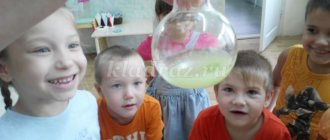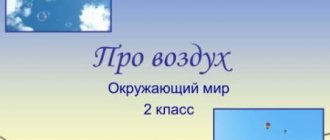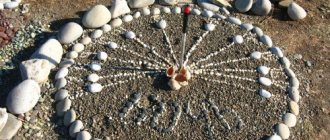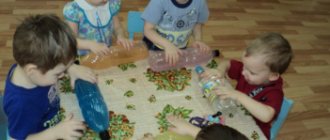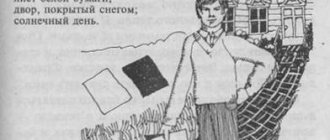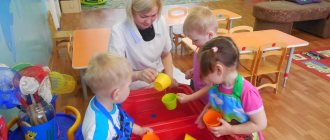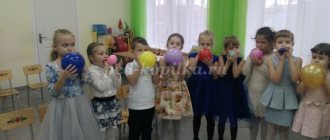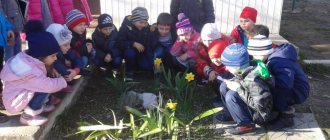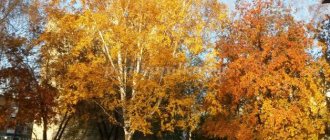Card index of experiences and experiments on ecology in the senior group
Card index of experiences and experiments in ecology
(in the older group)
Experiments with soil and wind
Experience No. 1
Purpose of the experience:
Show that there is air in the soil.
Contents of the experience:
Remind that in the Underground Kingdom - the soil - there are many inhabitants (earthworms, moles, beetles, etc.). What do they breathe? Like all animals, by air. Suggest checking to see if there is air in the soil. Place a soil sample in a jar of water and ask to see if air bubbles appear in the water. Then each child repeats the experience independently and draws appropriate conclusions. Everyone finds out together who has more air bubbles in the water.
Experience No. 2
Purpose of the experience:
Show that as a result of trampling of the soil (for example, on paths, playgrounds), the living conditions of underground inhabitants worsen, which means there are fewer of them. Help children independently come to the conclusion about the need to follow the rules of behavior on vacation.
Contents of the experience
: Remind the children where the soil samples were taken from (it is best to take them together with the children in areas that are familiar to them). Offer to express your hypotheses (where there is more air in the soil - in places that people like to visit, or where people rarely set foot) and justify them. Listen to everyone who wants to, summarize their statements, but do not evaluate them, because children must convince themselves of the correctness (or incorrectness) of their assumptions during the experiment. At the same time, lower the soil samples into jars of water and observe which one has more air bubbles (loose soil sample). Ask the children, where is it easier for underground inhabitants to breathe? Why is there less air “under the path”? (It may not be easy for children to answer this question, but let them at least try to do it. It is important that they learn to draw conclusions based on their experiments.) When we walk on the earth, we “press” on its particles, they seem to compressed, there is less and less air between them.
Experience No. 3
Contents of the experience:
Show that when a lump of earth is compressed, air seems to “leave” from it. (It is carried out as an addition to the previous one.) Give the children lumps of earth. Let them look at them and remember what they look like. Pay their attention to the fact that inside the lumps there are “empty spaces” - this is where the air “hides”. Then offer to squeeze a lump of earth in your hand. What happened to him? What has he become? Has it increased or decreased? Why did it decrease? The lump became smaller because there were fewer “empty spaces” between the particles of earth, they “pressed” against each other, and the air “gone”: there was no room left for it. In the same way, under the weight of our body, the earth on paths and roads compresses, and the air “leaves.”
Experience No. 4
Contents of the experience:
Show how soil pollution occurs; discuss the possible consequences of this. Invite the children to look at the water in both containers. What is the difference? Say that one contains clean rainwater; in the other there is dirty water left after washing. At home we pour this kind of water into the sink, but outside the city we simply throw it on the ground. Invite the children to express their hypotheses: what will happen to the earth if it is watered with clean water? What if it's dirty? Water the soil in one jar with clean water, and in the other with dirty water. What changed? In the first jar, the soil became wet, but remained clean: it can water a tree or a blade of grass. And in the second bank? The soil became not only wet, but also dirty: soap bubbles and streaks appeared. Place the jars nearby and offer to compare soil samples after watering.
Experience No. 5
Contents of the experience:
Bring children to an understanding and meaning of the properties of scattered sand.
Level the area with dry sand. Sprinkle sand evenly over the entire surface through a sieve. Immerse without pressing? pencil in the sand. Place a heavy object (for example, a key) on the surface of the sand. Pay attention to the depth of the mark left on... the sand by the object. Now shake the tray. Do the same with the key and pencil. In the collected sand, the pencil should be immersed approximately twice as deep as in the scattered sand. The imprint of a heavy object will be noticeably more distinct on scattered sand than on scattered sand.
Scattered sand is noticeably denser. This property is well known to builders.
Experience No. 6
Contents of the experience:
To lead children to understand and mean the properties of wet sand. Wet sand cannot be poured out of the palm of your hand, but it can take any desired shape until it dries. When sand gets wet, the air between the edges of the sand grains disappears, the wet edges stick to each other
Experience No. 7
Contents of the experience:
Show children the permeability of sand and the permeability of clay. Prepare two jars: one with sand, the other with clay. Pour the same amount of water into the jars. Find out why the water immediately passed through the sand and did not pass through the clay.
Experience No. 8
Contents of the experience:
Reinforce with children the concept of wind - air movement. To carry it out you will need two candles. The study should be carried out in cold weather. Open the door to the street slightly. Light the candles (remember to be safe!) Hold one candle at the bottom and the other at the top of the gap. Let the children determine where the flame of the candles “leans” (the flame of the lower one is directed into the room, the flame of the upper one is directed outward). Why is this happening? The air in our room is so warm. He travels easily and loves to fly. In the room, such air rises and escapes through the gap at the top. He wants to quickly get out and walk in freedom. And cold air creeps in from the street. He is cold and wants to warm up. Cold air is heavy and clumsy (after all, it is frozen), so it prefers to stay near the ground. Where does he enter our room from above or below? This means that at the top of the door crack the candle flame is “bent by warm air (he is running away from the room, flying into the street), and below by cold air (he is crawling towards us). It turns out that “one” air, warm, moves above, and “another”, cold, creeps towards it, below. Where warm and cold air move and meet, wind appears. Wind is the movement of air.
Experience No. 9
Contents of the experience:
Reinforce with children the concept of wind - air movement. Attach thin strips of paper or light fabric over the batteries. Listen to the children's guesses about what will happen to these stripes when you open the window. Will they move? Let the children touch the batteries to make sure they are warm. Is the air above the batteries warm or cold? We already know that warm air tends to rise. We open the window and let in cold air from the street (you can call it). The cold air from their window will go down (toward the radiator to warm up), and the warm air from the radiator will rise upward. So they will meet. What will appear then? Wind. And this wind makes the strips of paper move.
Experience No. 10
Contents of the experience:
Reinforce the concept of wind with the children. Lower the sailing boats (it’s good if they have multi-colored sails) onto the water. Children blow on the sails, the boats sail. Likewise, large sailing ships move thanks to the wind. What happens to a boat if there is no wind? What if the wind is very strong? A storm begins, and the boat may actually be wrecked (children can demonstrate all this)
Experience No. 11
Contents of the experience:
Reinforce the concept of wind with the children. For this experiment, use fans made in advance by the children themselves. You can also take real fans, which you, for example, prepared for costume dances. Children wave a fan over the water. Why did the waves appear? The fan moves and seems to push the air. The air also begins to move. And the children already know that wind is the movement of air (try to ensure that during the experiments the children draw as many independent conclusions as possible, because you have already discussed the question of where the wind comes from)
Experiment No. 12
Contents of the experience:
Reinforce the concept of wind with the children. Now let's wave the fan in front of our faces. How do we feel? Why did people invent the fan? What have we replaced the fan with in our lives? (Fan) It’s good to show pictures of women in costumes of the last century, with a fan.
Experiments with water
Experience No. 1
Contents of the experience:
1.Bring children to the understanding and importance of water and air for all living things.
2. Consolidation and generalization of knowledge about water and air.
Take a deep tray of any shape. Gather the children around the table and prepare the soil: sand, clay, rotted leaves. It would be nice to put earthworms there. Then plant a seed of a quickly germinating plant (vegetable or flower) there. Pour water and place in a warm place. Take care of the sowing with your children, and after a while a sprout will appear.
Experience No. 2
Contents of the experience:
1. Show children that water has no shape. Water has no form and takes the shape of the vessel into which it is poured. Show this to the children by pouring it into vessels of different shapes. Remember with your children where and how puddles spill.
Experience No. 3
Contents of the experience:
1. Bring children to understand that water has no taste. Water has no taste. Before experimenting, ask what the water tastes like. After this, let the children try plain boiled water. Then put salt in one glass, sugar in another, stir and let the children try. What taste does the water have now?
Experience No. 4
Contents of the experience:
1. Bring children to understand that water has no color. Water has no color.
Ask the children to put different colored crystals into glasses and stir until they dissolve. What color is the water now?
Experience No. 5
Contents of the experience:
1. Bring children to understand that water has no odor. Water has no smell. Ask the children what the water smells like? After answering, ask them to smell the water in the glasses with solutions (sugar and salt).
Then drop a fragrant solution into one of the glasses (but so that children cannot see). Now what does the water smell like?
Experience No. 6
Contents of the experience
1. Bring children to understand and value the life-giving properties of water. Life-giving properties of water. Cut off branches from trees that bloom quickly in advance. Take a vessel and label it “Water of Living.” Look at the branches with your children. After this, place the branches in the water and explain to the children that one of the important properties of water is to give life to all living things. Place the branches in a visible place. Time will pass and they will come to life.
Experience No. 7
Contents of the experience:
1. Bring children to understand the evaporation of water. Boil water, cover the vessel
lid and show how the condensed steam turns back into drops and falls down.
Experience No. 8
Contents of the experience:
Encourage children to understand surface tension. The jar is filled to the top with water. What happens when you carefully place a paper clip in a jar? The paperclip will displace a small amount of water, causing the water to rise above the rim of the jar. However, due to surface tension, the water will not overflow, only its surface will bend slightly.
Experience No. 9
Contents of the experience
1. Bring children to understand the connection between air temperature and the state of water (water turns into ice at low temperatures). Pour equal amounts of water from the tap into equal cups. Take one outside. Measure the air temperature outside and in the room. Determine the causes of water freezing.
Experience No. 10
Contents of the experience
1. Bring children to understand that snow melts when exposed to any heat source. Watch the snow melt on your hand on a frosty day. Watch the snow melt on your hand in a mitten.
Experience No. 11
Contents of the experience
"Ice is solid water."
If the experiment is carried out in winter, invite the children to choose their favorite icicle during the walk. Bring the icicles indoors, placing each one in a separate bowl so that the child can observe his or her icicle. If the experiment is carried out in the warm season, make ice cubes by freezing water in the refrigerator. Instead of icicles, you can take snow balls. Children should monitor the condition of icicles and ice cubes in a warm room. Draw their attention to how the icicles and ice cubes gradually decrease. What's happening to them? Remember the experience on the previous topic. Take one large icicle (one large ice cube) and several small ones. Watch which one melts faster - big or small.
It is important that children pay attention to the fact that pieces of ice that differ in size will completely melt in different periods of time.
In the same way, monitor the melting of snow. Conclusion: ice and snow are also water.
Experiment No. 12
Contents of the experience
"Ice is lighter than water."
Let the children express their guesses: what will happen to an ice cube if it is placed in a glass of water? Will it drown, float, maybe immediately dissolve? Listen to the children and then do the experiment. Ice floats in water. Tell the children that it is lighter than water, which is why it does not sink. Leave the ice in the cups and see what happens to it.
Experiment No. 13
Contents of the experience
“Steam is also water.”
To show children another state of water, take a thermos with boiling water. Open it up so the kids can see the steam. But we also need to prove that steam is also water. Place a glass or mirror over the steam. Droplets of water will appear on it, show them to the children. If you don’t have a thermos at hand, take an electric kettle or boiler and boil water in the presence of children, paying their attention to how more and more steam appears as the water boils.
Experiment No. 14
Contents of the experience
“Water is liquid and can flow.”
Give the children two glasses: one with water, the other empty, and ask them to carefully pour the water from one to the other. Is water flowing? Why? Because it's liquid. If water were not liquid, it would not be able to flow in rivers and streams, nor would it flow from a tap.
In order for children to better understand what “liquid” is, ask them to remember that jelly can be liquid and thick. If the jelly is flowing, we can pour it from glass to glass, and we say that it is... (children determine) liquid. If we cannot pour it from glass to glass, because it does not flow, but pours out in pieces, then we say that the jelly... (children's answer) is thick. Because water is liquid and can flow, it is called a liquid.
Experience No. 15
Contents of the experience
“Some substances dissolve in water, some do not.”
Take two glasses of water. Children will put regular sand in one of them and try to stir it with a spoon. What happens? Has the sand dissolved or not? Let's take another glass and pour a spoonful of granulated sugar into it, stir it. What happened now? In which of the cups did the sand dissolve? Remind children that they are constantly stirring sugar in their tea. If it did not dissolve in water, then people would have to drink unsweetened tea.
We put sand at the bottom of the aquarium. Does it dissolve or not? What would happen if granulated sugar, rather than regular sugar, was placed on the bottom of the aquarium? What if there was granulated sugar at the bottom of the river? (The children noted that in this case it would dissolve in water and then it would be impossible to stand on the bottom of the river.) Invite the children to stir watercolor paint in a glass of water. It is advisable that each child has his own paint, then you will get a whole set of multi-colored water. Why did the water become colored? The paint has dissolved in it.
Experiment No. 16
Contents of the experience
“Water can be warm, cold, hot.”
Give the children cups of water of different temperatures (you already showed them hot water when you studied steam). Let them try with their fingers and determine in which glass the water is the coldest and in which the warmest (of course, safety rules must be followed). If children are already familiar with the principle of operation of a thermometer, measure the temperature of water in different cups with them.
You can continue the previous experiment (No. 8) by comparing the temperature of the water before ice was put in it and after it melted. Why did the water become colder?
Emphasize that in rivers, lakes, and seas there is also water with different temperatures - both warm and cold. Some fish, animals, plants, snails can live only in warm water, others - only in cold water. If children were fish, what kind of water would they choose - warm or cold? What do they think, where are there more different plants and animals - in warm seas or in cold ones? Fewer different animals live in cold seas and rivers.
There are such unusual places in nature where very hot water comes out of the ground to the surface. These are geysers. They, like a thermos with hot water, also produce steam. What do the children think, can anyone live in such a hot “house”? There are very few inhabitants there, but they exist - for example, some algae.
It is important that preschoolers understand that water in reservoirs has different temperatures, which means that different plants and animals live in them.
Experiment No. 17
Contents of the experience
"Water has no form."
Have children look at an ice cube (remind that ice is solid water). What shape is this piece of ice? Will it change its shape if we put it in a glass, a bowl, or put it on a table or on our palm? No, it remains a cube in any place (until it melts). What about liquid water? Let the guys pour water into a jug, plate, glass (any container), onto the table surface. What's happening? Water takes the shape of the object in which it is located, and out of the blue it spreads into a puddle. This means that liquid water has no form.
The experiment can be supplemented by the following observations: a shaped ice cube melts into a liquid and spreads over the surface of the saucer.
Experience No. 18
Contents of the experience
1. Bring children to the understanding and meaning of air We need air to breathe. We inhale and exhale air.
Take a glass of water, insert a straw and exhale. Bubbles appear in the glass.
Experience No. 19
Contents of the experience
1. Bring children to the understanding and meaning of air. Make a small parachute. Show that when the parachute descends, the air beneath it expands the canopy, supporting it, so the descent occurs smoothly.
Experience No. 20
Contents of the experience
1. Lead children to understand the characteristics of air. Air is invisible, has no definite shape, spreads in all directions, and has no odor of its own. Take scented napkins, orange peels, etc. and invite the children to smell the odors in the room one by one.
Experiment No. 21
Contents of the experience:
Bring children to understand the weight of air Air has weight. Place inflated and uninflated balloons on the scales: the bowl with the inflated balloon will outweigh
Experiment No. 22
Contents of the experience:
Place the open plastic bottle in the refrigerator. When it is cool enough, place an uninflated balloon on its neck. Then, place the bottle in a bowl of hot water. Watch the balloon begin to inflate on its own. This happens because air expands when heated. Now put the bottle in the refrigerator again. The ball will deflate as the air compresses as it cools.
Experiments with magnet and sunlight.
Experience No. 1
Contents of the experience
1. Show children that sunlight consists of a spectrum, reinforce the idea of the seven colors of the rainbow. Equipment: a basin filled to the brim with water, a mirror installed in the water at an angle of 25 degrees; light source (sun or table lamp)
On a sunny day, place a basin of water near the window and lower a mirror into it. The mirror needs a stand, since the angle between it and the surface of the water should be 25 degrees. If the mirror “catch” a ray of light, then as a result of the refraction of the ray in the water and its reflection from the mirror on the wall or ceiling, a rainbow will appear.
This experiment can be carried out in the evening: then the light source will be a table lamp. The spectrum will be obtained in a darkened room.
Experience No. 2
Using a prism, you can create an image of a rainbow on the wall.
Experience No. 3
Contents of the experience
1. Show children that sunlight consists of a spectrum, reinforce the idea of the seven colors of the rainbow. Equipment: plate with water, nail polish, “fishing rod” for film. Place a drop of varnish into the water. A thin film forms on the surface of the water. It must be carefully removed using a special device - a “fishing rod”. The varnish film will play with all colors, reminiscent of the wings of a dragonfly. A ray of white light hitting a thin film is partially reflected from it, and partially travels deeper, reflecting from its inner surface.
Experience No. 4
Contents of the experience
1. Show children that sunlight consists of a spectrum, reinforce the idea of the seven colors of the rainbow. Equipment: sheet of paper, crystal glass.
Place the crystal glass on a white sheet of paper. Try to catch the sunshine with your glass. Rainbow colored stripes will appear on a sheet of paper.
Experience No. 5
Contents of the experience
1. Bring children to understand how a rainbow is formed. You can show the children a rainbow in the room. Place the mirror in the water at a slight angle. Catch a ray of sunlight with a mirror and direct it to the wall. Rotate the mirror until you see a spectrum on the wall. Water acts as a prism, decomposing light into its components. At the end of the lesson, ask the children what the word “ra-doo-ga” looks like? What is she like? Show the Rainbow with your hands. From the ground, a rainbow resembles an arc, but from an airplane it appears to be a circle.
Experience No. 6
Contents of the experience
Find out the ability of a magnet to attract certain objects. An adult demonstrates a trick: metal objects do not fall out of the mitten when unclenching his hand. Together with the children he finds out why. Invites children to take objects from other materials (wood, plastic, fur, fabric, paper) - the mitten ceases to be magical. Determine why (there is “something” in the mitten that prevents metal objects from falling). Children examine the mitten, find a magnet, and try to use it.
Experience No. 7
Contents of the experience
Identify the peculiarities of the interaction of two magnets: attraction and repulsion. An adult sets a task for the children: to determine how two magnets will behave if they are brought close to each other. Assumptions are checked by bringing one magnet to another suspended on a thread (they attract each other). Find out what will happen if you bring a magnet to the other side (they will repel; magnets can attract or repel, depending on which poles you bring them to each other).
Experience No. 8
Contents of the experience
Identify the properties of a magnet: the passage of magnetic forces through various materials and substances. An adult suggests finding out whether magnetic forces can act at a distance, how to check (slowly bring the magnet up and observe the object; the effect of the magnet stops at a great distance). They clarify whether magnetic forces can pass through different materials, what needs to be done for this (put an object on one side, a magnet on the other and move it). Select any material, check the effect of magnetic forces through it; cover small objects with something, bring a magnet, lift it; pour small objects onto the material being tested and bring a magnet from below. They conclude: magnetic forces pass through many materials. An adult invites children to think about how to find a lost watch in the sand on the beach, or a needle on the floor. Children's assumptions are tested: after placing small objects in the sand, they bring a magnet to the sand.
Experience No. 9
Contents of the experience
Find objects that interact with the magnet; identify materials that are not attracted to a magnet. Children examine all objects and identify materials. They make assumptions about what will happen to objects if a magnet is brought to them (some of them will be attracted to the magnet). The adult invites the children to select all the objects they named that will not be attracted to the magnet and name the material. Examine the remaining objects, naming the material (metals) and checking their interaction with the magnet. They check whether all metals are attracted by a magnet (not all; copper, gold, silver, aluminum are not attracted by a magnet).
Experience No. 10
Contents of the experience
Select objects that interact with the magnet. An adult and children look at the paper, make an airplane out of it, and tie it with a thread. Unbeknownst to the children, he replaces it with a plane with a metal plate, hangs it up and, bringing a “magic” mitten, controls it in the air. Children conclude: if an object interacts with a magnet, then it contains metal. Then the children look at the small wooden balls. Find out if they can move themselves (no). An adult replaces them with objects with metal plates, brings them a “magic” mitten, and makes them move. Determine why this happened (there must be something metal inside, otherwise the mitten will not work). Then the adult “accidentally” drops a needle into a glass of water and invites the children to think about how to get it out without getting their hands wet (hold a mitten with a magnet to the glass).
Experience No. 11
Contents of the experience
Determine the ability of metal objects to be magnetized. An adult invites children to bring a magnet to a paper clip, tell what happened to it (it was attracted), why (magnetic forces act on it). Carefully bring the paper clip to smaller metal objects, find out what happens to them (they are attracted to the paper clip), why (the paper clip has become “magnetic”). Carefully disconnect the first paper clip from the magnet, the second one holds on, find out why (the paper clip has become magnetized). Children make a chain of small objects, carefully bringing them one at a time to a previously magnetized object.
Experiment No. 12
Contents of the experience
Show the magnetic field around magnets. Children cover magnets with cardboard and bring paper clips. They find out how a magnet works: it sets paper clips in motion, they move under the influence of magnetic forces. Determine the distance at which the paper clip begins to be attracted to the magnet by slowly, from afar, bringing the paper clip to the magnet. Metal filings are slowly poured from a small height. They examine the resulting “magnetic” patterns, which are located more at the poles and diverge in the middle. Children find out that by combining several magnets they can “draw” an interesting “magnetic” picture.
Experiment No. 13
Contents of the experience
Identify the actions of the Earth's magnetic forces. An adult asks the children what will happen to the pin if you bring a magnet to it (it will be attracted because it is metal). They check the effect of a magnet on a pin, bringing it to different poles, and explain what they saw. Children find out how a needle will behave near a magnet by performing an experiment according to the algorithm: lubricate the needle with vegetable oil and carefully lower it to the surface of the water. From afar, slowly, at the level of the water surface, a magnet is brought up: the needle turns its end towards the magnet. Children lubricate the magnetized needle with fat and carefully lower it to the surface of the water. Notice the direction and carefully rotate the glass (the needle returns to its original position). Children explain what is happening by the action of the Earth's magnetic forces. Then they examine the compass and its structure, compare the direction of the compass arrow and the needle in the glass.
Experiment No. 14
Contents of the experience
Understand that the aurora is a manifestation of the Earth's magnetic forces. Children place a magnet under a sheet of paper. From another sheet at a distance of 15 cm, metal filings are blown through a tube onto the paper. Find out what is happening (the sawdust is arranged in accordance with the poles of the magnet). The adult explains that the magnetic forces of the Earth act in the same way, delaying the solar wind, the particles of which, moving towards the poles, collide with air particles and glow. Children, together with an adult, observe the attraction of small pieces of paper to a balloon electrified by friction with hair (the pieces of paper are particles of the solar wind, the balloon is the Earth).
Card index of ecology experiments (preparatory group)
Card index of ecology experiments (preparatory group)
Experiments with soil and wind Experiment No. 1
Purpose of the experiment Contents of the experiment To show that there is air in the soil.
Remind that in the Underground Kingdom - the soil - there are many inhabitants (earthworms, moles, beetles, etc.). What do they breathe? Like all animals, by air. Suggest checking to see if there is air in the soil. Place a soil sample in a jar of water and ask to see if air bubbles appear in the water. Then each child repeats the experience independently and draws appropriate conclusions. Everyone finds out together who has more air bubbles in the water. Experiment No. 2
Purpose of the experiment Contents of the experiment To show that as a result of trampling of the soil (for example, on paths, playgrounds), the living conditions of underground inhabitants worsen, which means that there are fewer of them.
Help children independently come to the conclusion about the need to follow the rules of behavior on vacation. Remind the children where the soil samples were taken from (it is better to take them together with the children in areas that are familiar to them). Offer to express your hypotheses (where there is more air in the soil - in places that people like to visit, or where people rarely set foot) and justify them. Listen to everyone, generalize their statements, but do not evaluate, because children must convince themselves of the correctness (or incorrectness) of their assumptions during the experiment. At the same time, lower the soil samples into jars of water and observe which one has more air bubbles (loose soil sample). Ask the children, where is it easier for underground inhabitants to breathe? Why is there less air “under the path”? (It may not be easy for children to answer this question, but let them at least try to do it. It is important that they learn to draw conclusions based on their experiments.) When we walk on the earth, we “press” on its particles, they as if they are compressed, there is less and less air between them. Experiment No. 3
Purpose of the experiment Contents of the experiment To show that when a lump of earth is compressed, air seems to “leave” from it. (It is carried out as an addition to the previous one.) Give the children lumps of earth. Let them look at them and remember what they look like. Pay their attention to the fact that inside the lumps there are “empty spaces” - that’s where the air is “hiding”. Then offer to squeeze a lump of earth in your hand. What happened to him? What has he become? Has it increased or decreased? Why did it decrease? The lump became smaller because there were fewer “empty spaces” between the particles of earth, they “pressed” against each other, and the air “gone”: there was no room left for it. In the same way, under the weight of our body, the earth on paths and roads compresses, and the air “leaves.”
Experience No. 4
Purpose of the experiment Contents of the experiment To show how soil pollution occurs;
discuss the possible consequences of this. Invite the children to look at the water in both containers. What is the difference? Say that one contains clean rainwater; in the other there is dirty water left after washing. At home we pour this water into the sink, but outside the city we simply throw it on the ground. Invite the children to express their hypotheses: what will happen to the earth if it is watered with clean water? What if it's dirty? Water the soil in one jar with clean water, and in the other with dirty water. What changed? In the first jar, the soil became wet, but remained clean: it can water a tree or a blade of grass. And in the second bank? The soil became not only wet, but also dirty: soap bubbles and streaks appeared. Place the jars nearby and offer to compare soil samples after watering. Experiment No. 5
Purpose of the experiment Contents of the experiment 1.
Bring children to an understanding and meaning of the properties of scattered sand. Level the area of dry sand. Sprinkle sand evenly over the entire surface through a sieve. Immerse without pressing? pencil in the sand. Place a heavy object (for example, a key) on the surface of the sand. Pay attention to the depth of the mark left on... the sand by the object. Now shake the tray. Do the same with the key and pencil. In the collected sand, the pencil should be immersed approximately twice as deep as in the scattered sand. The imprint of a heavy object will be noticeably more distinct on scattered sand than on scattered sand. Scattered sand is noticeably denser. This property is well known to builders. Experiment No. 6
Purpose of the experiment Contents of the experiment 1. To lead children to understand and mean the properties of wet sand. Wet sand cannot be poured out of the palm of your hand, but it can take any desired shape until it dries. When sand gets wet, the air between the edges of the sand grains disappears, the wet edges stick to each other
Experience No. 7
Purpose of the experiment Contents of the experiment 1. Show children the permeability of sand and the permeability of clay. Prepare two jars: one with sand, the other with clay. Pour the same amount of water into the jars. Find out why the water immediately passed through the sand and did not pass through the clay.
Experience No. 8
Purpose of the experiment Contents of the experiment 1.
Reinforce with children the concept of wind - air movement. To carry it out you will need two candles. The study should be carried out in cold weather. Open the door to the street slightly. Light the candles (remember to be safe!) Hold one candle at the bottom and the other at the top of the gap. Let the children determine where the flame of the candles “leans” (the flame of the lower one is directed into the room, the flame of the upper one is directed outward). Why is this happening? The air in our room is so warm. He travels easily and loves to fly. In the room, such air rises and escapes through the gap at the top. He wants to quickly get out and walk in freedom. And cold air creeps in from the street. He is cold and wants to warm up. Cold air is heavy and clumsy (after all, it is frozen), so it prefers to stay near the ground. Where does he enter our room from above or below? This means that at the top of the door crack the candle flame is “bent by warm air (he is running away from the room, flying into the street), and below by cold air (he is crawling towards us). It turns out that “one” air, warm, moves above, and “another”, cold, creeps towards it, below. Where warm and cold air move and meet, wind appears. Wind is the movement of air. Experiment No. 9
Purpose of the experiment Contents of the experiment 1. Reinforce with children the concept of wind - air movement. Attach thin strips of paper or light fabric over the batteries. Listen to the children's guesses about what will happen to these stripes when you open the window. Will they move? Let the children touch the batteries to make sure they are warm. Is the air above the batteries warm or cold? We already know that warm air tends to rise. We open the window and let in cold air from the street (you can call it). The cold air from their window will go down (toward the radiator to warm up), and the warm air from the radiator will rise upward. So they will meet. What will appear then? Wind. And this wind makes the strips of paper move.
Experience No. 10
Purpose of the experiment Contents of the experiment 1. Reinforce the concept of wind with the children. Lower the sailing boats (it’s good if they have multi-colored sails) onto the water. Children blow on the sails, the boats sail. Likewise, large sailing ships move thanks to the wind. What happens to a boat if there is no wind? What if the wind is very strong? A storm begins, and the boat may actually be wrecked (children can demonstrate all this)
Experience No. 11
Purpose of the experiment Contents of the experiment 1. Reinforce the concept of wind with the children. For this experiment, use fans made in advance by the children themselves. You can also take real fans, which you, for example, prepared for costume dances. Children wave a fan over the water. Why did the waves appear? The fan moves and seems to push the air. The air also begins to move. And the children already know that wind is the movement of air (try to ensure that during the experiments the children draw as many independent conclusions as possible, because you have already discussed the question of where the wind comes from)
Experiment No. 12
Purpose of the experiment Contents of the experiment 1.
Reinforce the concept of wind with the children. Now let's wave the fan in front of our faces. How do we feel? Why did people invent the fan? What have we replaced the fan with in our lives? (Fan) It’s good to show pictures of women in costumes of the last century, with a fan. Experiments with water Experiment No. 1
Purpose of the experiment Contents of the experiment 1. To bring children to the understanding and significance of water and air for all living things. 2. Consolidating and generalizing knowledge about water and air. Take a deep tray of any shape. Gather the children around the table and prepare the soil: sand, clay, rotted leaves. It would be nice to put earthworms there. Then plant a seed of a quickly germinating plant (vegetable or flower) there. Pour water and place in a warm place. Take care of the sowing with your children, and after a while a sprout will appear.
Experience No. 2
Purpose of the experiment Contents of the experiment 1. Show children that water has no shape. Water has no shape and takes the shape of the vessel into which it is poured. Show this to the children by pouring it into vessels of different shapes. Remember with your children where and how puddles spill.
Experience No. 3
Purpose of the experiment Contents of the experiment 1. Bring children to understand that water has no taste. Water has no taste. Before experimenting, ask what the water tastes like. After this, let the children try plain boiled water. Then put salt in one glass, sugar in another, stir and let the children try. What taste does the water have now?
Experience No. 4
Purpose of the experiment Contents of the experiment 1. Encourage children to understand that water has no color. Water has no color. Ask the children to put crystals of different colors in glasses and stir until they dissolve. What color is the water now?
Experience No. 5
Purpose of the experiment Contents of the experiment 1.
Bring children to understand that water has no smell. Water has no smell. Ask the children what the water smells like? After answering, ask them to smell the water in the glasses with solutions (sugar and salt). Then drop a fragrant solution into one of the glasses (but so that children cannot see). Now what does the water smell like? Experiment No. 6
Purpose of the experiment Contents of the experiment 1. Bring children to understand and mean the life-giving property of water. The life-giving property of water. Cut off branches from trees that bloom quickly in advance. Take a vessel, stick the label “Water of Living” on it. Together with the children, look at the twigs. After this, place the branches in the water and explain to the children that one of the important properties of water is to give life to all living things. Place the branches in a visible place. Time will pass and they will come to life.
Experience No. 7
Purpose of the experiment Contents of the experiment 1.
Bring children to understand the evaporation of water .
Boil water, cover the vessel with a lid and show how the condensed steam turns back into drops and falls down.
Experience No. 8
Purpose of the experiment Contents of the experiment To lead children to understand surface tension. The jar is filled to the top with water. What happens when you carefully place a paper clip in a jar? The paperclip will displace a small amount of water, causing the water to rise above the rim of the jar. However, due to surface tension, the water will not overflow, only its surface will bend slightly.
Experience No. 9
Purpose of the experiment Contents of the experiment 1. Encourage children to understand the relationship between air temperature and the state of water (water turns into ice at low temperatures) Pour equal amounts of water from the tap into equal cups. Take one outside. Measure the air temperature outside and in the room. Determine the causes of water freezing.
Experience No. 10
Purpose of the experiment Contents of the experiment 1.
Bring children to understand that snow melts when exposed to any heat source. Watch the snow melt on your hand on a frosty day. Watch the snow melt on your hand in a mitten. Experiment No. 11
Contents of the experiment “Ice is solid water.” If the experiment is carried out in winter, invite the children to choose their favorite icicle while walking. Bring the icicles indoors, placing each one in a separate bowl so that the child can observe his or her icicle. If the experiment is carried out in the warm season, make ice cubes by freezing water in the refrigerator. Instead of icicles, you can take snow balls. Children should monitor the condition of icicles and ice cubes in a warm room. Draw their attention to how the icicles and ice cubes gradually decrease. What's happening to them? Remember the experience on the previous topic. Take one large icicle (one large ice cube) and several small ones. Keep track of which one will melt faster - the big one or the small one. It is important that children pay attention to the fact that pieces of ice that differ in size will completely melt in different periods of time. In the same way, monitor the melting of snow. Conclusion: ice and snow are also water.
Experiment No. 12
Content of the experience. "Ice is lighter than water." Let the children express their guesses: what will happen to an ice cube if it is placed in a glass of water? Will it drown, float, maybe immediately dissolve? Listen to the children and then do the experiment. Ice floats in water. Tell the children that it is lighter than water, which is why it does not sink. Leave the ice in the cups and see what happens to it.
Experiment No. 13
Contents of the experiment “Steam is also water.” To show children another state of water, take a thermos with boiling water. Open it up so the kids can see the steam. But we also need to prove that steam is also water. Place a glass or mirror over the steam. Droplets of water will appear on it, show them to the children. If you don’t have a thermos at hand, take an electric kettle or boiler and boil water in the presence of children, paying their attention to how more and more steam appears as the water boils.
Experiment No. 14
Contents of the experiment “Water is liquid and can flow.” Give the children two glasses: one with water, the other empty, and offer to carefully pour the water from one to the other. Is water flowing? Why? Because it's liquid. If water were not liquid, it would not be able to flow in rivers and streams, and would not flow from the tap. In order for children to better understand what “liquid” is, invite them to remember that jelly can be liquid and thick. If the jelly is flowing, we can pour it from glass to glass, and we say that it is... (children determine) liquid. If we cannot pour it from glass to glass, because it does not flow, but pours out in pieces, then we say that the jelly... (children's answer) is thick. Because water is liquid and can flow, it is called a liquid.
Experience No. 15
Contents of the experiment “Some substances dissolve in water, some do not.” Take two glasses of water. Children will put regular sand in one of them and try to stir it with a spoon. What happens? Has the sand dissolved or not? Let's take another glass and pour a spoonful of granulated sugar into it, stir it. What happened now? In which of the cups did the sand dissolve? Remind children that they are constantly stirring sugar in their tea. If it did not dissolve in water, then people would have to drink unsweetened tea. We put sand at the bottom of the aquarium. Does it dissolve or not? What would happen if granulated sugar, rather than regular sugar, was placed on the bottom of the aquarium? What if there was granulated sugar at the bottom of the river? (The children noted that in this case it would dissolve in water and then it would be impossible to stand on the bottom of the river.) Invite the children to stir watercolor paint in a glass of water. It is advisable that each child has his own paint, then you will get a whole set of multi-colored water. Why did the water become colored? The paint has dissolved in it.
Experiment No. 16
Contents of the experiment “Water can be warm, cold, hot.” Give the children cups of water of different temperatures (you already showed them hot water when you studied steam). Let them try with their fingers and determine in which glass the water is the coldest and in which the warmest (of course, safety rules must be followed). If children are already familiar with the principle of operation of a thermometer, measure the temperature of water in different cups with them. You can continue the previous experiment (No. 8) by comparing the temperature of the water before ice was put in it and after it melted. Why did the water become colder? Emphasize that in rivers, lakes, and seas there is also water with different temperatures - both warm and cold. Some fish, animals, plants, snails can live only in warm water, others - only in cold water. If children were fish, what kind of water would they choose - warm or cold? What do they think, where are there more different plants and animals - in warm seas or in cold ones? Fewer different animals live in cold seas and rivers. There are such unusual places in nature where very hot water comes out of the ground to the surface. These are geysers. They, like a thermos with hot water, also produce steam. What do the children think, can anyone live in such a hot “house”? There are very few inhabitants there, but they do exist - for example, some algae. It is important that preschoolers understand that water in reservoirs has different temperatures, which means different plants and animals live in them.
Experiment No. 17
Contents of the experiment “Water has no shape.” Invite the children to look at an ice cube (remind that ice is solid water).
What shape is this piece of ice? Will it change its shape if we put it in a glass, a bowl, or put it on a table or on our palm? No, it remains a cube in any place (until it melts). What about liquid water? Let the guys pour water into a jug, plate, glass (any container), onto the table surface. What's happening? Water takes the shape of the object in which it is located, and out of the blue it spreads into a puddle. This means that liquid water has no shape. The experiment can be supplemented with the following observations: an ice cube that has a shape melts into a liquid and spreads over the surface of the saucer. Experiment No. 18
Purpose of the experiment Contents of the experiment 1. Bring children to the understanding and meaning of air We need air to breathe. We inhale and exhale air. Take a glass of water, insert a straw and exhale. Bubbles appear in the glass.
Experience No. 19
Purpose of the experiment Contents of the experiment 1. To introduce children to the understanding and importance of air Make a small parachute. Show that when the parachute descends, the air underneath it expands the canopy, supporting it! it, so the decrease occurs smoothly.
Experience No. 20
Purpose of the experiment Contents of the experiment 1.
Lead children to understand the characteristics of air .
Air is invisible, has no definite shape, spreads in all directions, and has no odor of its own. Take scented napkins, orange peels, etc. and invite the children to smell the odors in the room one by one.
Experiment No. 21
Purpose of the experiment Contents of the experiment 1. Bring children to understand the weight of air Air has weight. Place inflated and uninflated balloons on the scales: the bowl with the inflated balloon will outweigh
Experiment No. 22
Contents of the experiment Place the open plastic bottle in the refrigerator. When it is cool enough, place an uninflated balloon on its neck. Then, place the bottle in a bowl of hot water. Watch the balloon begin to inflate on its own. This happens because air expands when heated. Now put the bottle in the refrigerator again. The ball will deflate as the air compresses as it cools.
